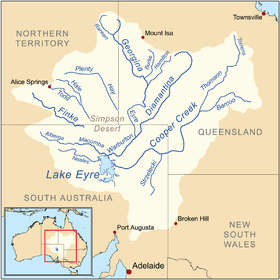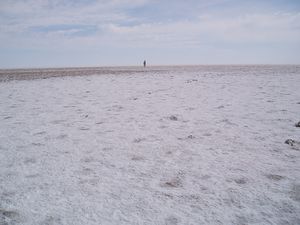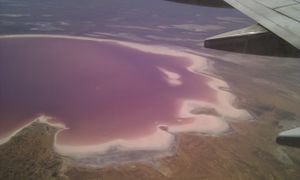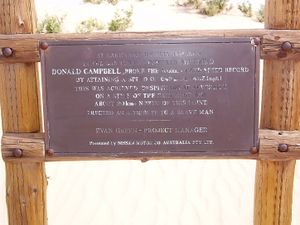بحيرة إير
| Kati Thanda–Lake Eyre | |
|---|---|
 Composite Landsat 7 satellite image using shortwave infrared, near-infrared, and blue wavelengths | |
 A map of the Lake Eyre basin, with the lake at bottom left | |
| الموقع | Northern South Australia |
| الإحداثيات | 28°22′S 137°22′E / 28.367°S 137.367°E |
| Lake type | Endorheic |
| الموارد الرئيسية | Warburton River |
| التصريفات الرئيسية | evaporation |
| بلدان الحوض | Australia |
| مساحة السطح | 9،500 km2 (3،668 sq mi) (max) |
| متوسط العمق | 1.5 m (5 ft) (every 3 years), 4 m (13 ft) (every decade) |
| ارتفاع السطح | −9 m (−30 ft) (shoreline when full); −15 m (−49 ft) (lowest point when empty) |
Lake Eyre (/ɛər/ AIR), officially known as Kati Thanda–Lake Eyre,[1] contains the lowest natural point in Australia, at approximately 15 m (49 ft) below sea level (AHD), and, on the rare occasions that it fills, is the largest lake in Australia covering 9،500 km2 (3،668 sq mi). The shallow endorheic lake is the depocentre of the vast Lake Eyre basin and is found in Northern South Australia, some 700 km (435 mi) north of Adelaide.
When the lake is full, it has the same salinity level as the sea, but as the lake dries up and the water evaporates, salinity increases.
The lake was named in honour of Edward John Eyre, who was the first European to see it, in 1840. The lake's official name was changed in December 2012 to combine the name "Lake Eyre" with the indigenous name, Kati Thanda.[1] The native title over the lake and surrounding region is held by the Arabana people.[2]
الجغرافيا
محاولات تسجيل رقم قياسي للسرعة على الأرض
Kati Thanda–Lake Eyre has been a site for various land speed record attempts on its salt flats, especially those by Donald Campbell with the Bluebird-Proteus CN7.[3]
انظر أيضاً
الهامش
- ^ أ ب "New name adopted for outback Lake Eyre". Australian Broadcasting Corporation. 19 December 2012. Retrieved 19 December 2012.
- ^ "Federal Court awards native title over Lake Eyre". ABC News. Australia. 23 May 2012. Retrieved 2 January 2012.
- ^ John Pearson (author). Bluebird and the Dead Lake.
{{cite book}}:|author=has generic name (help)
وصلات خارجية
- NASA Earth Observatory pages on Lake Eyre:
- Fluctuations of Lake Eyre, South Australia - 5 December 2002 Accessed 5 February 2014.
- Lake Eyre, South Australia - 24 March 2003 Accessed 5 February 2014.
- Lake Eyre Filling Peaks - 21 June 2009 Accessed 5 February 2014.
- Lake Eyre Yacht Club website Accessed 5 February 2014.
- Samela Harris: Lake Eyre pelican mystery Accessed 5 February 2014.
- Dr Vincent Kotwicki: Floods of Lake Eyre Accessed 5 February 2014.
- Salt, an award-winning documentary about Lake Eyre by filmmaker Murray Fredericks



